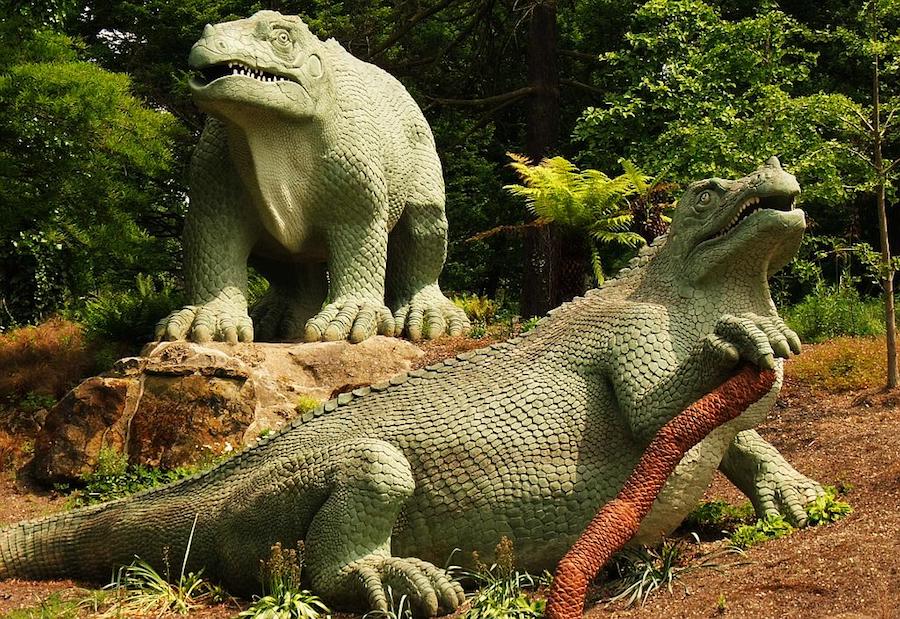The Crystal Palace Dinosaurs, are a collection of thirty exceptional, life-size sculptures of prehistoric creatures. They stand as a testament to the scientific and artistic achievements of a pre Darwin (The Origin of Species wasn’t published until 1859) 19th century. Languishing in an overgrown park, once home to the now destroyed Crystal Palace (Mark 2), the Dinosaurs are one of the few remnants left of the Great Exhibition of 1851.
The models, constructed from a mishmash of ceramic, concrete and glass ignited a public fascination with a long-lost prehistoric world. Their significance sheds a light on how scientific understanding and popular culture were impacted by these awesome creatures.
In 1851 as the Industrial Revolution was in full swing, London hosted the Great Exhibition in the grand Crystal Palace. Sir Richard Owen, a renowned anatomist and palaeontologist, was appointed to oversee the creation of the world’s first dinosaur sculptures. Working alongside talented sculptor Benjamin Waterhouse Hawkins, Owen meticulously reconstructed prehistoric creatures based on the limited scientific knowledge of the time. Many of the characteristics are fantasy. However, he did manage to capture the essence of these fascinating beasts. It is no wonder that the sculptures still are a popular much-loved attraction.

Despite their impressive size and artistic merit, the Crystal Palace Dinosaurs faced criticism for their speculative nature. The scientific understanding of dinosaurs was still in its infancy, and many sculptures displayed anatomical inaccuracies. Nevertheless, they served as essential educational tools, sparking public interest in palaeontology and inspiring future scientific discoveries.
The Crystal Palace Dinosaurs offered Victorian visitors a compelling journey into the ancient past. Stepping into the prehistoric wonderland, the public marvelled at the towering sculptures of the Megalosaurus, Iguanodon, and Hylaeosaurus, among others. The exhibit transported viewers to a time when colossal reptiles roamed the Earth, leaving a lasting impact on the collective imagination.
Beyond their scientific significance, the Crystal Palace Dinosaurs left an indelible mark on Victorian culture. The fascination with dinosaurs captured the popular imagination, influencing literature, art, and fashion. From the works of Charles Dickens and Arthur Conan Doyle to the illustrations of Sir Arthur Rackham, the dinosaurs permeated the Victorian literary and artistic landscape.
As the years passed, the Crystal Palace Dinosaurs faced deterioration due to weathering and vandalism. However, their cultural value led to various preservation and restoration efforts. In the 21st century, the sculptures have been designated as Grade I listed structures and continue to be cherished and protected.

The Crystal Palace Dinosaurs remain a remarkable testament to the Victorian era’s scientific curiosity, artistic vision, and cultural impact, their legacy endures as a symbol of human ingenuity and imagination. Today, these iconic sculptures stand as a reminder of the enduring allure of prehistoric mysteries and the power of art and science to captivate and inspire generations.
Benjamin Waterhouse Hawkins was a pioneering sculptor and natural history artist. Born 8 February 1807 in London, Hawkins showed an early talent and passion for art, mainly sculpting and illustration.
Hawkins’ career as a sculptor took flight in the early 1830s when he gained recognition for his work on various public commissions and scientific illustrations. His keen interest in geology and palaeontology led him to collaborate with eminent palaeontologist Sir Richard Owen on their groundbreaking project. Despite the lack of complete dinosaur skeletons, Hawkins ingeniously used the existing fossil evidence to create lifelike and imaginative representations of these ancient beasts.
Hawkins continued to work on various public commissions, including creating sculptures for London’s Natural History Museum. His passion for art and science resonated throughout his career as he continued to illustrate and sculpt various subjects related to natural history. Despite facing financial difficulties later in life, Hawkins remained committed to his artistic pursuits. In 1881, he moved to the United States, where he continued to work on sculptures and illustrations until his passing in 1894.
Benjamin Waterhouse Hawkins’ contribution to palaeontology and his artistic legacy lives on through the enduring appeal of the Crystal Palace Dinosaurs. His ability to merge art and science left an indelible mark on the popular understanding and appreciation of prehistoric life, inspiring generations of artists and scientists to explore the wonders of the natural world through the lens of creativity and curiosity.
Bromley Council recently announced a regeneration plan for the park – including a £17.5m project to restore the park’s original features such as the remaining Crystal Palace Dinosaurs, the Italian Terraces and the site of the former palace itself.
Top Photo: Pterosaurs at Crystal Palace, based on “Pterodactylus cuvieri”. Ben Sutherland Creative Commons Attribution 2.0 File:Crystal Palace pterosaurs. jpg|Crystal_Palace_pterosaurs

![Pterosaurs at Crystal Palace, based on "Pterodactylus cuvieri".[1] Ben Sutherland Creative Commons Attribution 2.0 Crystal Palace pterosaurs.jpg Copy [[File:Crystal Palace pterosaurs.jpg|Crystal_Palace_pterosaurs]] Copy Dinosaurs Sculptures](https://artlyst.com/wp-content/uploads/2023/07/Crystal_Palace_pterosaurs.jpg)